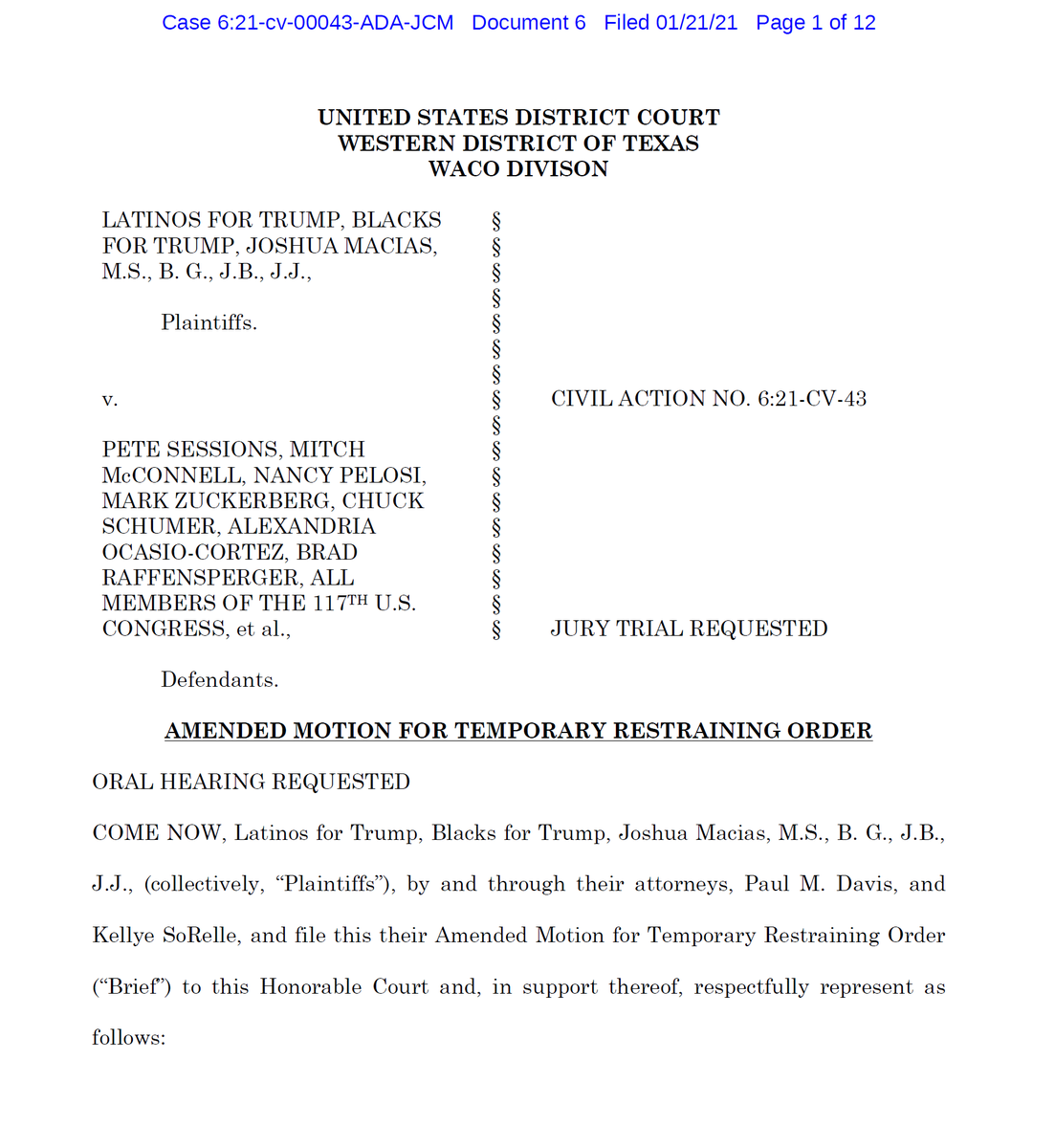So technically it's still unclear what she's suing over.
Good afternoon, followers of frivolous performative litigation.
New filing in Orly Tatiz's bonkers attempt to halt the 2nd Impeachment trial. It's a gloriously burning train wreck of mangled formatting and hideous typography.
Let's dig
So technically it's still unclear what she's suing over.
Even though, honestly, it's not the worst Orly has produced.
"an inartfully collated, defectively stapled, and misordered collection of pages" is still one of my favorite descriptions of a filing ever.


No, really, that's how it's styled.




All of this takes place without legal argument of any recognizable variety.





Also, we're talking about things that will happen on the 25th in a document that wasn't filed until the 26th.




Over a decade of legal malcraptice and she still hasn't managed to master that one simple trick.

Also, yeah, that's not going to be proper service on the United States. Again.

More from Mike Dunford
Election Litigation Update: DC - the "let's sue the Electoral College" case.
This is a bit surprising, given that as of last time I checked nobody had been served and no appearance had been entered. I suspect it's an effort to make sure the case isn't "pending" on the 6th.
And, sure enough, still no proof of service on ANY defendant, still no appearance from defense counsel. And this is denying the motion for preliminary injunction but does NOT dismiss the case - which is potentially ominous for plaintiff's counsel.

This isn't a "happy judge" kind of first paragraph. Not even a little bit. Nope.

Y'all, this isn't even directed within a few hundred miles of my direction and I sill just instinctively checked to make sure that there's room for me to hide under my desk if I have to - this is a very not happy, very federal, very judge tone.

Also - the judge just outright said there's a bunch of reasons for dismissal. And not in "might be" terms. In definite fact ones. But the case isn't dismissed yet.
If I was plaintiffs counsel, I'd definitely be clearing under my desk right now, and possibly also my underwear.
This is a bit surprising, given that as of last time I checked nobody had been served and no appearance had been entered. I suspect it's an effort to make sure the case isn't "pending" on the 6th.
Link: https://t.co/oOJZD1F4x2
— Brad Heath (@bradheath) January 4, 2021
And, sure enough, still no proof of service on ANY defendant, still no appearance from defense counsel. And this is denying the motion for preliminary injunction but does NOT dismiss the case - which is potentially ominous for plaintiff's counsel.

This isn't a "happy judge" kind of first paragraph. Not even a little bit. Nope.

Y'all, this isn't even directed within a few hundred miles of my direction and I sill just instinctively checked to make sure that there's room for me to hide under my desk if I have to - this is a very not happy, very federal, very judge tone.

Also - the judge just outright said there's a bunch of reasons for dismissal. And not in "might be" terms. In definite fact ones. But the case isn't dismissed yet.
If I was plaintiffs counsel, I'd definitely be clearing under my desk right now, and possibly also my underwear.
Yes, I have seen the thing about Texas suing other states over the election. Yes, the US Supreme Court has original and exclusive jurisdiction over cases between states.
No, this is not a thing that will change the election. At all.
If this is real - and I do emphasize the if - it is posturing by the elected Republican "leadership" of Texas in an attempt to pander to a base that has degraded from merely deplorable to utterly despicable.
Apparently, it is real. For a given definition of real, anyway. As Steve notes, the Texas Solicitor General - that's the lawyer who is supposed to represent the state in cases like this - has noped out and the AG is counsel of
Although - again - I'm curious as to the source. I'm seeing no press release on the Texas AG's site; I'm wondering if this might not be a document released by whoever the "special counsel" to the AG is - strange situation.
Doesn't matter. The Supreme Court is Supremely Unlikely to take this case - their jurisdiction is exclusive, but it's also discretionary.
Meaning, for nonlawyers:
SCOTUS is the only place where one state can sue another, but SCOTUS can and often does decline to take the case.
No, this is not a thing that will change the election. At all.
If this is real - and I do emphasize the if - it is posturing by the elected Republican "leadership" of Texas in an attempt to pander to a base that has degraded from merely deplorable to utterly despicable.
Apparently, it is real. For a given definition of real, anyway. As Steve notes, the Texas Solicitor General - that's the lawyer who is supposed to represent the state in cases like this - has noped out and the AG is counsel of
It looks like we have a new leader in the \u201ccraziest lawsuit filed to purportedly challenge the election\u201d category:
— Steve Vladeck (@steve_vladeck) December 8, 2020
The State of Texas is suing Pennsylvania, Georgia, Michigan, and Wisconsin *directly* in #SCOTUS.
(Spoiler alert: The Court is *never* going to hear this one.) pic.twitter.com/2L4GmdCB6I
Although - again - I'm curious as to the source. I'm seeing no press release on the Texas AG's site; I'm wondering if this might not be a document released by whoever the "special counsel" to the AG is - strange situation.
Doesn't matter. The Supreme Court is Supremely Unlikely to take this case - their jurisdiction is exclusive, but it's also discretionary.
Meaning, for nonlawyers:
SCOTUS is the only place where one state can sue another, but SCOTUS can and often does decline to take the case.
More from Society
You May Also Like
MDZS is laden with buddhist references. As a South Asian person, and history buff, it is so interesting to see how Buddhism, which originated from India, migrated, flourished & changed in the context of China. Here's some research (🙏🏼 @starkjeon for CN insight + citations)
1. LWJ’s sword Bichen ‘is likely an abbreviation for the term 躲避红尘 (duǒ bì hóng chén), which can be translated as such: 躲避: shunning or hiding away from 红尘 (worldly affairs; which is a buddhist teaching.) (https://t.co/zF65W3roJe) (abbrev. TWX)
2. Sandu (三 毒), Jiang Cheng’s sword, refers to the three poisons (triviṣa) in Buddhism; desire (kāma-taṇhā), delusion (bhava-taṇhā) and hatred (vibhava-taṇhā).
These 3 poisons represent the roots of craving (tanha) and are the cause of Dukkha (suffering, pain) and thus result in rebirth.
Interesting that MXTX used this name for one of the characters who suffers, arguably, the worst of these three emotions.
3. The Qian kun purse “乾坤袋 (qián kūn dài) – can be called “Heaven and Earth” Pouch. In Buddhism, Maitreya (मैत्रेय) owns this to store items. It was believed that there was a mythical space inside the bag that could absorb the world.” (TWX)
1. LWJ’s sword Bichen ‘is likely an abbreviation for the term 躲避红尘 (duǒ bì hóng chén), which can be translated as such: 躲避: shunning or hiding away from 红尘 (worldly affairs; which is a buddhist teaching.) (https://t.co/zF65W3roJe) (abbrev. TWX)
2. Sandu (三 毒), Jiang Cheng’s sword, refers to the three poisons (triviṣa) in Buddhism; desire (kāma-taṇhā), delusion (bhava-taṇhā) and hatred (vibhava-taṇhā).
These 3 poisons represent the roots of craving (tanha) and are the cause of Dukkha (suffering, pain) and thus result in rebirth.
Interesting that MXTX used this name for one of the characters who suffers, arguably, the worst of these three emotions.
3. The Qian kun purse “乾坤袋 (qián kūn dài) – can be called “Heaven and Earth” Pouch. In Buddhism, Maitreya (मैत्रेय) owns this to store items. It was believed that there was a mythical space inside the bag that could absorb the world.” (TWX)

























